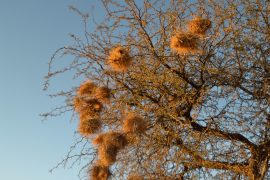Life in the Dunes
Written by Kali Tindell
My name is Kali Tindell and I’m currently a junior in high school. This past summer I had the opportunity to visit Namibia, an ecologically and culturally diverse country on the south-western coast of Africa, and study both wildlife conservation and photography with National Geographic Student Expeditions. I was introduced to the many ways nonprofits conserve Namibia’s habitats and felt inspired to share my experience. I hope these blogs encourage you to learn about how conservation can be fun and to take a closer look at what makes your environment unique.
 If I were to show you a picture of a Namibian sand dune, would you believe it is home to any life? Sure, a thorny bush may be rooted at its base and a few blades of brittle grass may grow beside it, but is that enough to convince you that a thriving ecosystem is captured in that photo?
If I were to show you a picture of a Namibian sand dune, would you believe it is home to any life? Sure, a thorny bush may be rooted at its base and a few blades of brittle grass may grow beside it, but is that enough to convince you that a thriving ecosystem is captured in that photo?
As we piled into the trucks, I wasn’t completely convinced that we would see much on our living desert tour. However, I was excited nonetheless. The three tour trucks followed the same gravel path that they follow on every other tour and that’s not because they’re not adventurous. On the gravel plains hugging the coast of Namibia in the Dorob National Park, right outside the city of Swakopmund, tracks made by both humans and animals can last a lifetime. There isn’t enough water to wash the tracks away (rain is a rare event in this desert) and the wind isn’t strong enough to erase marks in the gravel. Our guides stressed the importance of stepping in the tracks of those before us so that we would reduce our impact on the plain.

Barely a few minutes after entering the park, our caravan of trucks came to a halt. One of the guides had spotted a small rivet in an otherwise flat and sandy area. We looked out the window curiously, wondering what animal was hidden beneath the sand, before filing out of the trucks and around the spot in question. Sure enough, a pale, spotted Palmato gecko was hidden beneath a layer of sand. Its little body blended in the orange-yellow surroundings perfectly. Without the help of our guide, I doubt we would have discovered the little reptile. We also spotted a Namaqua chameleon, a Peringuey’s adder, a shovel-snouted lizard, numerous beetles, and Tractrac chats that afternoon.
 You might be thinking, how in the world do these animals survive? The key is fog. Both the plants and the animals rely on fog. Beetles, for instance, harvest water from the fog by using their own bodies. Grooves in the body of the beetle direct the condensation collected on abdomen and thorax toward its mouth. Just like the beetles, the dollar bush uses its glossy leaves to direct water toward its roots. If you were to squeeze one of its round leaves, you would find that the plant holds a lot of moisture. Thus, it’s not surprising that many animals in the park use the dollar bush for hydration.
You might be thinking, how in the world do these animals survive? The key is fog. Both the plants and the animals rely on fog. Beetles, for instance, harvest water from the fog by using their own bodies. Grooves in the body of the beetle direct the condensation collected on abdomen and thorax toward its mouth. Just like the beetles, the dollar bush uses its glossy leaves to direct water toward its roots. If you were to squeeze one of its round leaves, you would find that the plant holds a lot of moisture. Thus, it’s not surprising that many animals in the park use the dollar bush for hydration.
It’s hard to believe that an area as dry and stark as Dorob National Park is home to so many different species (some of which are found nowhere else on the planet). In an area this harsh, animals need numerous adaptations to survive. Visiting the dunes and gravel plains of Namibia has really made me appreciate the complexity and awesomeness of nature even more.
